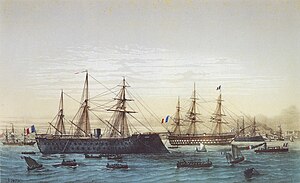French ironclad Magenta

| |
| History | |
|---|---|
| Name | Magenta |
| Namesake | Battle of Magenta |
| Builder | Brest |
| Laid down | 22 June 1859 |
| Launched | 22 June 1861 |
| Fate | Exploded and sank, 31 October 1875 |
| General characteristics (as built) | |
| Class and type | ironclad |
| Displacement | 6,965 t (6,855 long tons) |
| Length | 88.6 m (290 ft 8 in) |
| Beam | 17.34 m (56 ft 11 in) |
| Draft | 8.44 m (27 ft 8 in) |
| Installed power |
|
| Propulsion | 1 shaft, 1 horizontal-return connecting rod-steam engine |
| Sail plan | Barquentine-rig |
| Speed | 12.88 knots (23.85 km/h; 14.82 mph) (trials) |
| Range | 1,840 nautical miles (3,410 km; 2,120 mi) at 10 knots (19 km/h; 12 mph) |
| Complement | 674 |
| Armament |
|
| Armor | |
Magenta was the
Mediterranean Squadron
.
Design and description
The Magenta class were two-decked ironclad
draft of 8.44 meters (27 ft 8 in). The ship displaced 6,965 t (6,855 long tons).[1] The Magentas were equipped with a metal-reinforced, spur-shaped ram, the first ironclads to be fitted with a ram,[2] and they had a crew of 674 officers and enlisted men.[1]
The Magenta-class ships had a single two-cylinder
kW) and was intended to give the ships a speed in excess of 13 knots (24 km/h; 15 mph).[2] During their sea trials, sister ship Solférino[3] achieved a speed of 12.88 knots (23.85 km/h; 14.82 mph) from 4,012 metric horsepower (2,951 kW).[1] The Magenta class carried enough coal to allow them to steam for 1,840 nautical miles (3,410 km; 2,120 mi) at a speed of 10 knots (19 km/h; 12 mph).[4] They were originally fitted with a three-masted barquentine rig that had a sail area of 1,711 square meters (18,420 sq ft), but they were re-rigged as barques with 1,960 m2 (21,100 sq ft) in 1864–1865.[3][4]
Armament and protection
The
pivot mounts as chase guns fore and aft.[1][3][4][5] In the late 1860s all of the guns on the lower gun deck were removed and their armament was changed to four 240-millimeter (9.4 in) RMLs and eight 194 mm smoothbores, two each of the latter fore and aft as chase guns on the upper gun deck. Their final armament consisted of ten 240 mm Modèle 1864–66 guns and four 194 mm guns as chase guns fore and aft.[1][3]
The Magentas had a full-length
wrought-iron plates 120 mm (4.7 in) thick. Above the belt both gun decks were protected with 109 mm (4.3 in) of armor, but the ends of the ships were unprotected.[2]
Construction and career

On 21 July 1875, Magenta was serving as flagship in a naval exercise involving six
dispatch vessel, to pass astern of Magenta to receive orders. Attempting to place his ship in the column between Magenta and Jeanne d′Arc, the commanding officer of Forfait misjudged his turn, and Jeanne d′Arc collided with Forfait, her ram bow tearing into Forfait′s side. Forfait sank 14 minutes later, her crew of 160 taking safely to her boats; her commanding officer floated free from the bridge as Forfait sank beneath him, but also was rescued.[6][7]

On 31 October 1875, an accidental nighttime
Pricot de Sainte-Marie
mission.
The wreck was located in April 1994. Fragments of stelae have since been recovered.[8] The statue has been partially recovered, though the head was too damaged to be rejoined to the rest of the statue. The fragments are on display at the Louvre in Paris.[9]
Notes
- ^ a b c d e f Gille, p. 24
- ^ a b c d Campbell, p. 287
- ^ a b c d e de Balincourt & Vincent-Bréchignac, p. 25
- ^ a b c d Silverstone, p. 62
- ^ Konstam, p. 19
- ^ Rockwell, p. 146
- ^ dawlishchronicles.blogspot.com The ramming of the Forfait by the Jeanne d’Arc, 1875
- ^ "Le Magenta : statue de l'impératrice Sabine". culture.gouv.fr (in French). 2001. Retrieved 20 March 2013.
- ^ "Site officiel du musée du Louvre". cartelfr.louvre.fr (in French). 2013. Retrieved 20 March 2013.
References
Wikimedia Commons has media related to Magenta_(ship,_1862).
- de Balincourt, Captain & Vincent-Bréchignac, Captain (1974). "The French Navy of Yesterday: Ironclad Frigates, Part I". F.P.D.S. Newsletter. II (2): 18. OCLC 41554533.
- de Balincourt, Captain & Vincent-Bréchignac, Captain (1974). "The French Navy of Yesterday: Ironclad Frigates, Pt. II". F.P.D.S. Newsletter. II (3): 23–25. OCLC 41554533.
- Campbell, N. J. M. (1979). "France". In Chesneau, Roger & Kolesnik, Eugene M. (eds.). Conway's All the World's Fighting Ships 1860–1905. Greenwich, UK: Conway Maritime Press. pp. 282–333. ISBN 0-8317-0302-4.
- Gille, Eric (1999). Cent ans de cuirassés français [A Century of French Battleships] (in French). Nantes: Marines. ISBN 2-909-675-50-5.
- Jones, Colin (1996). "Entente Cordiale, 1865". In McLean, David & ISBN 0-85177-685-X.
- Konstam, Angus (2019). European Ironclads 1860–75: The Gloire Sparks the Great Ironclad Arms Race. Oxford, UK: Osprey Publishing. ISBN 978-1-47282-676-3.
- Roberts, Stephen S. (2021). French Warships in the Age of Steam 1859–1914: Design, Construction, Careers and Fates. Barnsley, UK: Seaforth Publishing. ISBN 978-1-5267-4533-0.
- Roche, Jean-Michel (2005). Dictionnaire des bâtiments de la flotte de guerre française de Colbert à nos jours, 1671 – 1870. Group Retozel-Maury Millau. OCLC 165892922.
- Silverstone, Paul H. (1984). Directory of the World's Capital Ships. New York: Hippocrene Books. ISBN 0-88254-979-0.
- Wilson, H. W. (1896). Ironclads in Action: A Sketch of Naval Warfare From 1855 to 1895. Vol. 1 and 2. Boston: Little, Brown.
- Winfield, Rif & Roberts, Stephen S. (2015). French Warships in the Age of Sail, 1786–1861. Barnsley, UK: Seaforth Publishing. ISBN 978-1-84832-204-2.
